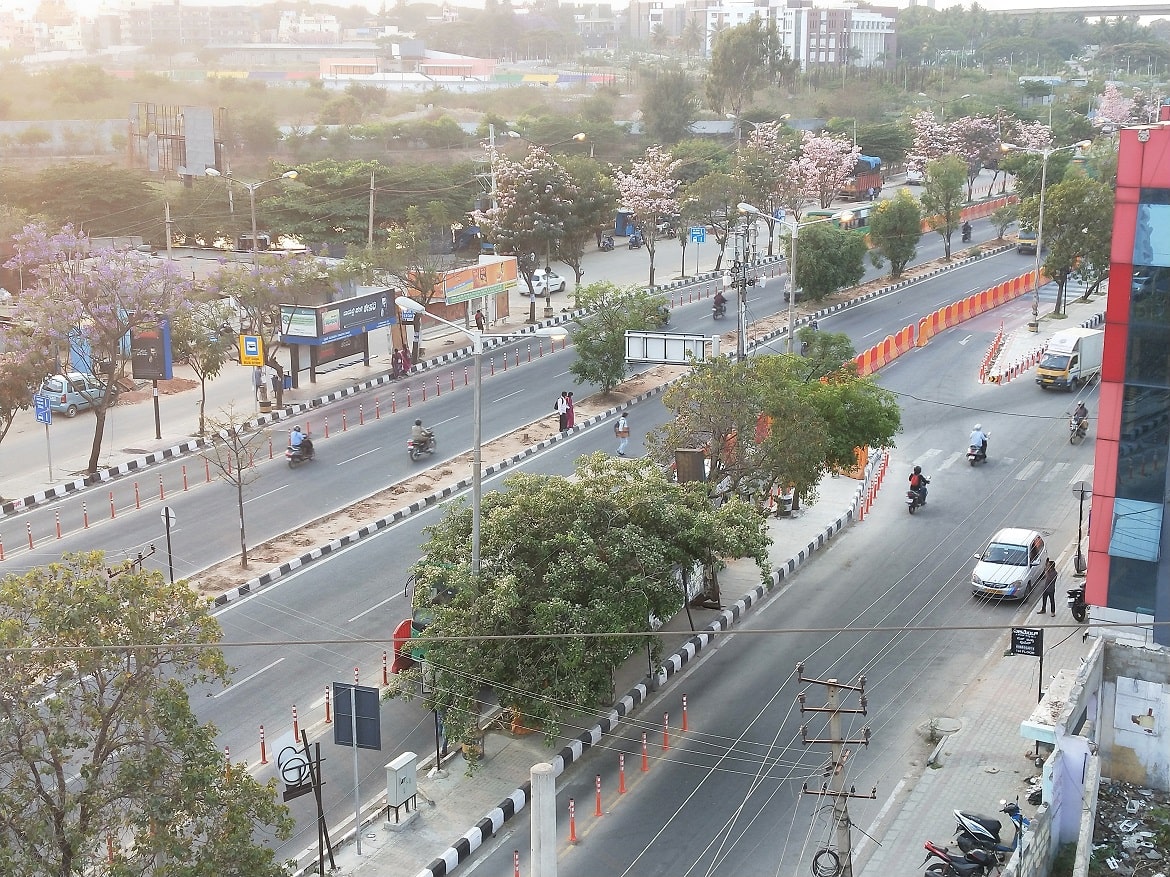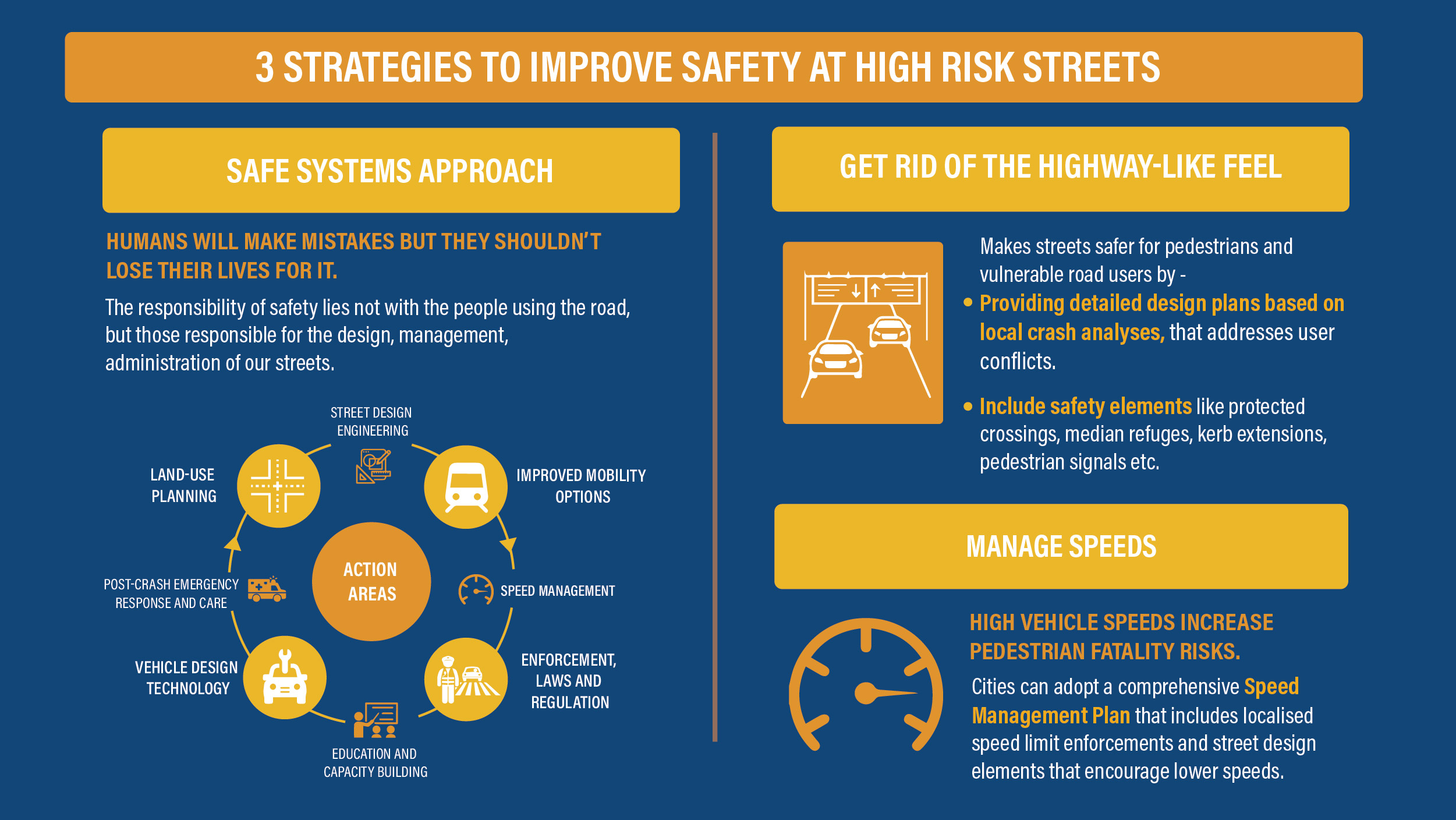Bengaluru's ORR is not safe for pedestrians: Three ways to make it better

This blog first appeared on The News Minute on June 22, 2021
Pedestrians, the most vulnerable and oft-ignored of road-users, suffer the most in road crashes. Between 2015 and 2018, nearly 73,000 pedestrians were killed in crashes across India. In 2019, Bengaluru recorded the highest number of pedestrian deaths (272) in the country. Most of these crashes in Bengaluru, take place on arterial roads, mainly on the 62km-long Outer Ring Road (ORR) that encircles the city. The ORR is a major link in the city’s road network, connecting states and national highways. It is also a major employment hub as the 17km-long, KR Puram to Silk Board stretch generates 30% of the city’s IT revenues.
The ORR is lined with residential complexes, educational institutions and informal settlements, and sees a lot of footfalls. However, the ORR is designed as a highway to mainly facilitate vehicle movement. Wide travel lanes and signal-free stretches, aided by the construction of flyovers and underpasses, encourage high vehicle speeds. The lack of pedestrian infrastructure forces people to walk on the carriageway, making them vulnerable to road crashes.
A quarter of Bengaluru’s blackspots — locations with a high concentration of road traffic deaths and grievous injuries — are on the ORR. The upcoming metro line, the ORR’s redevelopment as a high-density corridor and associated real estate growth will only exacerbate the problem. The Bengaluru Mission 2022 plan seeks to ‘revitalise Bengaluru into a sustainable, connected city enhancing the quality of life of its citizens’. In a city where 40% of those dying in crashes are pedestrians, focusing on three key strategies to make high-risk arterial roads safer, will help strengthen this mission.
Embrace the ‘Safe Systems Approach’
The Safe Systems approach emphasises shared responsibility and a systems-based framework to improving safety. The approach hinges on the principle that humans will make mistakes but should not lose their lives on account of it. Furthermore, safety lies not just with the people using the road and must consider all involved in approvals, design and implementation including policymakers, law enforcement officials, engineers and administrators.
The Haryana Vision Zero program, based on this approach, recorded a 10% reduction in fatalities in 2018. Projects were taken up under the four ‘E’s of road safety endorsed by the Ministry of Road Transport and Highways — Engineering (crash investigation, road safety audits), Enforcement (zero-tolerance drives, automatic e-challans), Education (road safety awareness campaigns) and emergency care (implementation of highway traffic assistance booths).
These were coordinated locally, in each district, ensuring efficient management. Bengaluru too can adopt a similar model with the ORR being divided into 15km-long segments for local action. Systematic improvements across the four ‘E’s can be operationalised in each segment under a multi-stakeholder initiative involving the corporation, traffic police, citizen groups and other agencies.

Get rid of the ‘Highway-like’ feel
Given Bengaluru’s rapid urban expansion, many streets no longer function as they were originally intended. The ORR was built as a bypass road in the 1990s, but today functions, for all practical purposes, as an urban street. Unfortunately, the ‘highway-like’ feel of the ORR, in the form of fenced medians and minimal pedestrian crossings, makes it unsafe for pedestrians.
Take the case of New York City’s Queens Boulevard, nicknamed as the ‘Boulevard of Death’ due to the high number of road traffic fatalities. To resolve this, the New York City Department of Transportation made a few changes to the street design. They added wider medians, kerb extensions, repainted crosswalks, signage and protective barriers, adjusted signal timings and closed many slip lanes to remove the ‘highway-like’ feel. This helped decrease pedestrian crashes by 68%, transforming it into the ‘Boulevard of Life’.
Similar measures can be implemented at the ORR. The high-density corridor upgradation project already includes streetscape improvements such as footpaths, cycle lanes, bus bays and landscaping. A detailed design plan, based on local crash analysis, that addresses user conflicts and provides safety elements will further improve the project. Some safety elements that can be considered include protected crossings, median refuges, kerb extensions, pedestrian signals, informational signage and redesigned intersections.
Manage speeds for safer and efficient travel
High vehicle speeds increase pedestrian fatality risks. Over 90% of Bengaluru’s road traffic fatalities in 2019 took place due to speeding. While average vehicle speeds during peak hours may be low, 83% of crashes occur during off-peak hours when speeds increase, as per Bengaluru Traffic Police data. During the pandemic, the fatal crash rate increased by 4%, most likely due to increased speeding on empty roads.
In Bogota, Colombia, a Speed Management Program (SMP) helped address this issue. After enforcing a 50 kmph speed limit, seven arterial roads recorded a 27% reduction in traffic fatalities. Bengaluru can adopt a comprehensive SMP that can include localised speed limit enforcements and street design elements that encourage lower speeds, such as the recently implemented raised pedestrian crossings by the corporation.
Views expressed are the author’s own.
